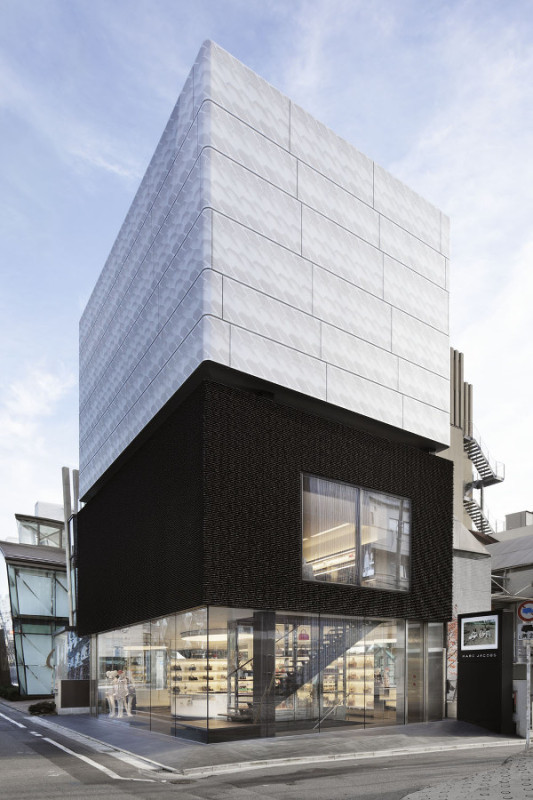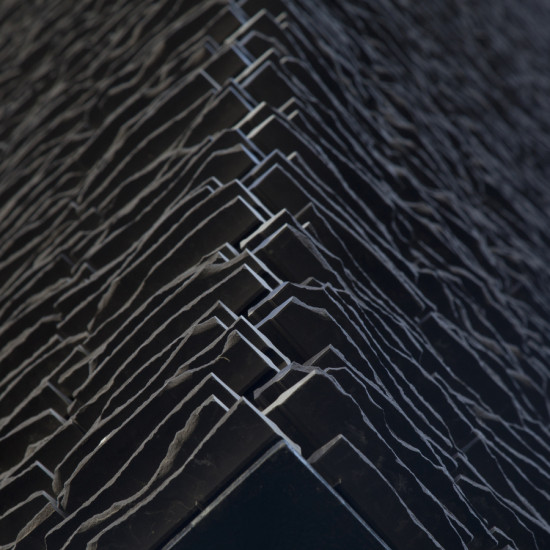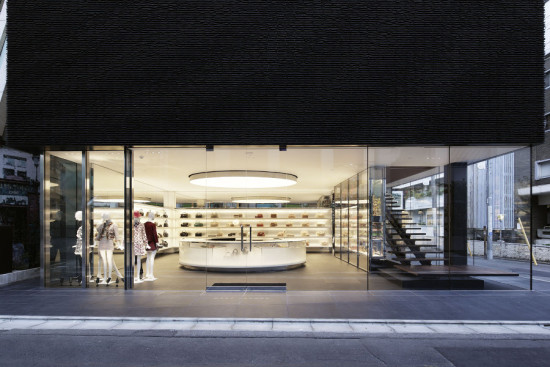
Marc Jacobs flagship store features a tripartite facade of aluminum, tile, and glass.
Commissioned to design Marc Jacobs‘ flagship Tokyo store, Jaklitsch/Gardner Architects‘ first order of business was to rectify the desire for an iconic urban presence with strict local regulations. To make the 2,800-square-meter shop more visible from nearby Omotesando Street, the architects took advantage of a loophole in the building code that allowed them to double the height of the structure as long as the top half was not occupiable. The catch was that the code required a 500-millimeter gap between the occupiable and non-occupiable spaces. “Our first strategy was to create a louvered facade system that would disguise [the divide],” recalled principal Stephan Jaklitsch. But after an afternoon walk through the Imperial gardens, they reversed course. “We were inspired by the vernacular architecture,” said project architect Jonathan Kirk. “We wanted to somehow utilize the language of proportions, but also the materiality within that experience. Rather than trying to create something that was monolithic, we began to look at different materials for each of the building’s components.” The result, called Tōrō Ishi Ku (lantern-rock-void), makes its mark on the city with a tripartite facade in punched aluminum, bespoke tile, and glass.

The top, non-occupiable half of the store is wrapped in stamped aluminum panels. Jaklitsch came up with the idea of a patterned two-dimensional facade after a trip to Prague Castle. “There was a smooth facade, but it employed a visual trick to deliver an illusion of depth,” he said. “We were in a sense doing the same thing [in Tokyo]. It looks like a quilted facade, and appears to wrap around seamlessly.” The texture of small punched holes was derived from a method of fabrication common throughout Tokyo. Behind the aluminum, the architects installed a fabric scrim that in turn reflects light from a series of LEDs, so that the upper portion of the building—the tōrō, or lantern—glows at night.
A second optical illusion concerns the size of the aluminum panels themselves. Each large rectangular aluminum panel in fact comprises four separate aluminum pieces bolted together. Deep reveal seams between each four-part component result from turning the edges over to create rigidity, and also allow for thermal expansion and movement during seismic activity. “What ends up looking very simple in presentation is actually quite complex,” said Kirk.

Jaklitsch/Gardner defined the central portion of the building—the ishi, or “rock” containing a ready-to-wear showroom—with an opaque rain screen of bespoke tile. The building falls within a fire zone, so the architects were restricted to either fire glass or a non-combustible material. “Because it was also a more private program, and because we were dealing with various conditions in the adjacent buildings, we clad the entire thing in porcelain tile,” explained Kirk. The sole exceptions are a single window on each of the building’s east and west faces. The blade-shaped tiles were made from molds with a score joint in the middle. Each larger component was broken in two to create bespoke texturing along two edges; the half-tiles were then randomized and arranged in offset rows to form an interlocking pattern at the building’s corners.

- Facade Manufacturer
LIXIL (porcelain tile) - Architects
Jaklitsch/Gardner Architects - Facade Installer
Kitano Construction Corp. - Location
Tokyo, Japan - Date of Completion
December 2010 - System
punched aluminum panels over tensile fabric, porcelain tile over extruded concrete panel with aluminum clip system, transparent glass - Products
custom punched anodized aluminum panels, LIXIL custom porcelain tile, tensile fabric, optical clear tempered glass
The architects had originally intended to adhere the tile directly to the second floor’s extruded concrete exterior, but the porcelain proved too heavy. Instead, they worked with the manufacturer to develop a custom fixing solution, in which the tiles are held off the wall by a series of metal studs. As a result, said Kirk, “the tiles can appear continuous across the concrete panels, which have seams about every three feet. The tiles are independent of the seams because the mounting brackets aren’t affected by them.” Like the aluminum panels above, the tiles are designed to move freely in case of an earthquake.
Tōrō Ishi Ku’s “void”—its ground-floor display room—is a transparent glass box. “We went through a number of different studies to get the proportions of the first and second floor just right,” said Jaklitsch. The architects discovered that by restricting the height to three meters, they could eliminate the need for anchoring fins, thus increasing the sense of openness to the surrounding buildings. The feeling of continuity between inside and out is further emphasized by the use of honed granite for both the interior floor and the surrounding sidewalks. In this case, Jaklitsch/Gardner’s sleight-of-hand worked too well. After several pedestrians collided with the glass, the architects modified the design by applying a subtle vertical striping to the exterior glass at eye level.
One final consideration helped shape the shop’s unique envelope: the rapidity with which the surrounding built environment is changing. The life expectancy of structures in the area averages only 26 years, explained Jaklitsch. Even as they were designing Tōrō Ishi Ku, the building across the street was torn down. “It became a matter of balancing the massing with this transitional zone between the commercial and residential districts,” he said. “We were trying to anticipate the next three chess moves in this urban game.”

